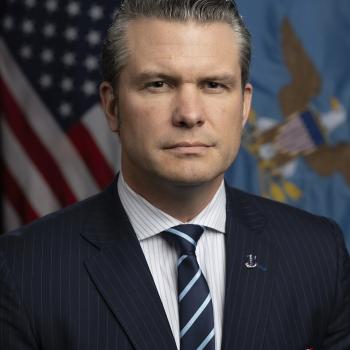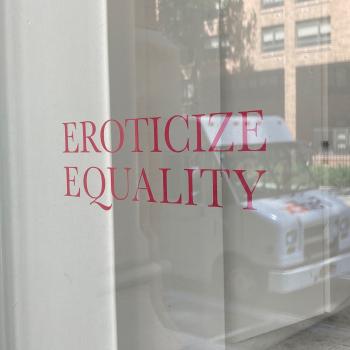Gender theory is in part a response to the oppressiveness of socially constructed gender norms. A young boy who likes dancing and cooking, or a young girl who likes sports and comic books, should not be made to feel that they aren’t masculine or feminine enough. Forcing people away from their interests because it doesn’t fit into a narrowly conceived notion of what is normal is extremely damaging psychologically.

This casts a light on the need to temper certain exaggerated, even fetishitic, expressions of gender. I see this in many of my students, who think being a real man is about exerting power over others . . . what many are now calling “toxic masculinity.” When removed from the ideal of self-gift embodied in fatherhood, it shouldn’t be surprising that so many young men are attracted to extreme performances of masculinity — be it through violence, abuse of others, or the demonstration of sexual prowess.
While the Church can align itself with some of the critiques of socially constructed gender norms, it must remain firm in its condemnation of relativism and anthropological dualism. Though men can express their masculinity in a variety of ways, young people ought not be told that their gender identity is arbitrary. The fact that your body is male means something. Your body, and all of the material world, is beautiful because it is a gift from God. It’s a gift that is full of meaning and purpose, in so far as it teaches you how to love others, and how to give to them in a particular mode.
The issue with gender theory is not that it questions socially constructed norms of gender, but that it totally separates gender from the body. Furthermore, it encourages people to think that they have the agency to determine their own identity. It assumes that nature does not exist and that we are free to construct our own truth.
Far from being liberating, this seems to just solidify the binary which it attempts to escape. If I have a student who is not as athletic as his classmates, should I tell him that maybe his interests indicates that he is actually a girl . . . and that he should consider transitioning? Were he to become a woman, this would only further bolster the idea that men should act like this and women should act like that.
Equivocating on this matter puts the well-being of the poor at stake. While the rich can clean up the mess brought about by their libertinism with a variety of tools and “professional help” (birth control, medical treatments, psychological counseling), for the poor and underprivileged this often ends in violence and despair. Being a teacher of inner-city young men, I find it crucial to be clear on what constitutes the masculine genius. The lie that freedom and happiness are subject to our own whims is particularly destructive for young underprivileged men. Their masculine genius often atrophies into a drive for selfishness, domination, and abuse — giving them the illusion that it’s okay to “hit it and leave it,” even if he impregnates his sexual partner. This reality of absent fatherhood has done nothing but harm the lives of so many of my students.
The attitude of openness and listening that the document calls for can seem to be contradicted by the clear judgments it offers on the errors of gender theory. But affirming the gender binary as a God-given fact need not be used as a weapon to mock and belittle those who struggle to come to terms with their bodies. As Pose demonstrates, people with GD continue to face abuse and violence, which must be unequivocally condemned.
Those with GD need more than to be reminded that “God doesn’t make mistakes.” Telling them that they just need to accept the body God gave them will likely be of little assistance. Instead, they would benefit from a nuanced approach informed by an authentic Christian anthropology and sound psychological research.
Mark Yarhouse, a clinical psychologist at Regent University, offers a compelling response that remains committed to orthodox Christian doctrine while being sensitive to the realities that those with GD face. Perhaps the most innovative aspect of his method is his ability to integrate three seemingly conflicting “lenses” to respond to people with GD.
The three lenses are integrity, disability, and diversity.
The integrity lens emphasizes Genesis 1 and 2 and God’s creational intent.
The disability lens focuses on how gender identity and biological sex do not align and this is a nonmoral variation that occurs in nature. It isn’t tied to moral categories in quite the same way I see happening among those who are proponents of the integrity framework. From the disability framework, gender dysphoria exists because something is not functioning properly, which I think creates more empathy and compassion for the person navigating gender identity concerns. Christians drawn to the disability lens often see lack of proper functioning as the result of the fall in Genesis 3.
The diversity lens looks at these variations as reflecting a sense of identity and community. A strong form of the diversity lens wishes to deconstruct the male-female binary, viewing this binary as a source of oppression.
Through his extensive research and clinical experience with those with GD, Yarhouse’s “integrated lens” is able to bring together the best of these lenses, without compromising his commitment to the Truth of the person.
For me, an integrated lens recognizes that the integrity lens is right in placing a high view of Scripture and God’s creational intent. It seems to me that a Christian account of gender and sex begins here. The strength of the integrity lens is the emphasis on Genesis 1 and 2. But what I appreciate about the disability lens is the way people there recognize the reality of Genesis 3. We live in a fallen world, and the fall has touched all of creation, including our experience of our gender. What the diversity lens brings to the discussion is the emphasis on identity and community. Again, these are emotionally compelling answers to fundamental longings for personhood and place in the world.
In a time when people with GD are turned into political footballs in a match waged between opposing teams, Yarhouse’s nuanced writings offer a breath of fresh air. His realism is a far cry from the politicization of the issue, thus enabling him to accommodate people in their actual situations while maintaining the normative premises of a Christian anthropology.
Yarhouse accepts that some people with GD may need to cross-dress or take hormones in order to deal adequately with their dysphoria. But he recommends that counselors, doctors, and pastors attempt to help the person to sort out their dysphoria and, if possible, to reconcile with their biological sex, before making any significant adjustments to their gender expression. When it’s deemed absolutely necessary, he suggests to opt for the least invasive changes possible, saving sex-reassignment surgery as a last resort. Yarhouse cites numerous examples of people who received a reassignment surgery who, years later, wanted to transition back, and experienced significant psychological trauma from not being able to do so.
Above all, the Vatican’s document is an invitation to pay closer attention to the needs of the human person. What was the human person made for? What does she need in order to flourish? These questions apply to all people, male and female, and those who struggle to reconcile with their own gender.
The tendency of postmodern ideology to reduce the person to a receptacle of pleasure and unfettered freedom limits her capacity to achieve communion with the Truth for which she was made. The Church, in her mission of accompanying humanity in this pursuit, must speak boldly and compassionately, following the example of her Bridegroom, who loved the “littlest of these” to the point of dying for them. This mission must remain in constant dialogue with the changing circumstances in which humanity finds itself.
How can she listen attentively without compromising who she is, but instead being led forward by the Spirit which promises her integrity, her wholeness and unity with the Bridegroom? Let’s pray that this mission can continue to foster a “revolution of tenderness” in the lives of all people today.
This is the first part of an article I previously published with Homiletic and Pastoral Review on “Male and Female He Created Them,” the Congregation for Catholic Education’s document on gender theory and education, which was published around this time last year. I will continue posting the subsequent parts of the article within this series.















